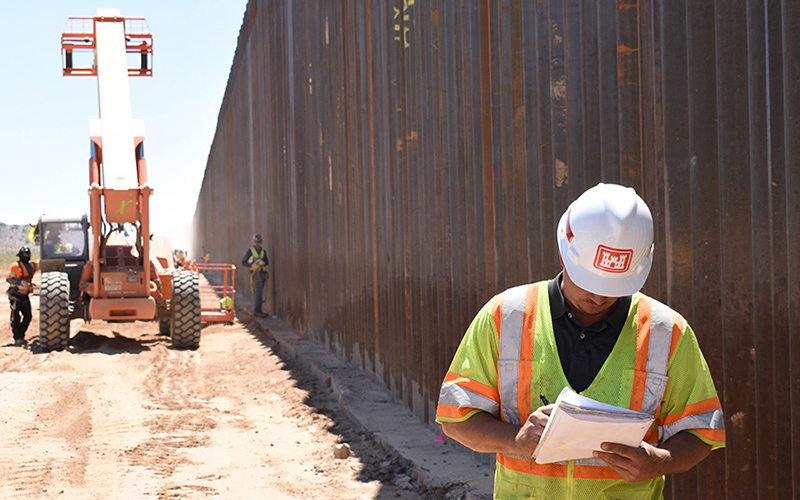
A U.S. Army Corps of Engineers contractor takes notes during work on the border wall near Yuma last month. The bulk of the $15 billion budgeted for the border wall to date has come from the Defense Department. (Photo by Robert DeDeaux/U.S. Army Corps of Engineers)
PHOENIX – President Donald Trump is set to visit Yuma Tuesday to celebrate the completion of 216 miles of border wall, well shy of the 450 miles he has pledged to have built by the end of this year.
But experts note that the pace of construction has picked up in recent years and that, with elections looming this fall, the administration has a powerful incentive to keep pressing ahead.
“The Trump administration is spending money on the wall at an unprecedented level,” said Jessica Bolter, an associate policy analyst at the Migration Policy Institute.
A report Friday by Customs and Border Protection said that since Trump took office in 2017, $15 billion has been budgeted for about 738 miles of wall along the southwest border.
Supporters of the wall say it’s money well spent.
“This is the most important issue facing our nation. Our border must be secured,” Rep. Paul Gosar, R-Prescott, said in a statement Monday. “Yuma is on the front lines of this defense and I am proud to have supported additional border security.”
Critics of the wall see it differently, calling the project wasteful and environmentally harmful. Democrats have scheduled a news conference in advance of Trump’s visit to say he should be focusing on the economy and the coronavirus instead.
Vicki Gaubeca, the director of the Southern Border Communities Coalition, criticized Trump’s border visit, saying his “focus on re-election is a detriment to everyone else.” She said the president’s main priority should be dealing with COVID-19 than the wall.
“I think it’s ridiculous – it’s this notion that he has, that he has to fulfill this campaign promise,” Gaubeca said.
Trump campaigned in 2016 on a pledge to build a wall along the 1,954-mile border with Mexico, a wall that he said at the time that Mexico would pay for.
In its report Friday, CBP said the $15 billion budgeted so far for the wall has come from the Department of Homeland Security budget and from Defense Department funds for military construction and for counter-narcotics operations. Money was also allocated from the Treasury Forfeiture Fund. Most of that funding, $9.9 billion, is from the Pentagon.
Almost all of the 216 miles built so far have been replacements for older, existing border barriers that were constructed under the Secure Fence Act of 2006, CBP said.
Alex Nowrasteh, an analyst at the Cato Institute, noted that the wall currently costs about $20 million a mile, and he expects costs to continue rising as more and more miles are added. That does not include annual maintenance costs, which he estimates at about $800,000 per mile per year.
Trump’s visit comes at a time when apprehensions have fallen close to the lowest levels in his presidency. CBP apprehended 23,118 migrants at the border in May, up slightly from April but a far cry from the 144,116 apprehensions in May 2019. This May’s numbers were among the lowest levels since this time in 2017.
The drop in apprehensions was not lost on Gaubeca.
“You can tell that things are shifting because not only are immigration and apprehension numbers really, really low, but we’re also seeing CBP and ICE (Immigration and Customs Enforcement) agents being deployed to monitor protests, which makes me think they obviously don’t have anything to do now,” she said.
Sen. Martha McSally, R-Arizona, disagreed, saying she was “looking forward to showing him (Trump) the completion of 200 miles of the border wall in Yuma.”
“Representing a border state, I know firsthand how important this barrier is to our nation’s border security as cartels and drug traffickers attempt to take advantage of a porous border,” she said in a statement Monday.

